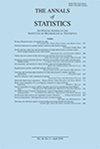有或没有缺失的当前状态审查的尖锐极小最大值分布估计
IF 3.2
1区 数学
Q1 STATISTICS & PROBABILITY
引用次数: 1
摘要
通过当前状态截尾(CSC)修改的寿命X的累积分布函数和概率密度的非参数估计,包括左右缺失数据的情况,是一个具有偏差数据的经典不适定问题。CSC数据的偏差性质可能会使我们无法进行一致的估计,除非偏差函数是已知的或可以估计的,并且其不适定性质会减慢收敛速度。在传统研究的CSC下,我们观察到来自$(Z,\Delta)$的样本,其中连续监测时间$Z$独立于$X$,$\Delta:=I(X\leq Z)$是状态,并且观测的偏差由$Z$的密度产生,这是可估计的。在存在右或左缺失的情况下,我们观察到来自$(\Delta Z,\Delta)$或$((1-\Delta(Z,\Deleta))$的相应样本;数据再次有偏差,但现在不能根据数据估计$Z$的密度。因此,为了解决估计问题,必须知道$Z$的密度(就像在对照研究中一样),或者进行额外的$Z$横截面抽样,这通常比基础CSC研究更简单。本文的主要目的是针对这一有偏和不适定性问题发展有效(尖锐极小极大)估计理论,该理论受到直接观测$X$情况下已知结果的启发。在所发展的理论的有趣方面中:(i)虽然缺失CSC的尖锐极小极大分析可能遵循经典的Pinsker方法,但CSC的分析需要基于频域和时域中的特殊平滑的更复杂的估计过程;(ii)有效的估计需要解决近似非周期Sobolev函数的老问题;(iii)如果$X$的cdf的光滑性是已知的,则即使$Z$的密度更粗糙,其速率最小最大估计也是可能的。给出了真实和模拟的例子,以及将核心模型扩展到依赖$X$和Z以及病例对照CSC。本文章由计算机程序翻译,如有差异,请以英文原文为准。
Sharp minimax distribution estimation for current status censoring with or without missing
Nonparametric estimation of the cumulative distribution function and the probability density of a lifetime X modified by a current status censoring (CSC), including cases of right and left missing data, is a classical ill-posed problem with biased data. The biased nature of CSC data may preclude us from consistent estimation unless the biasing function is known or may be estimated, and its ill-posed nature slows down rates of convergence. Under a traditionally studied CSC, we observe a sample from $(Z,\Delta )$ where a continuous monitoring time $Z$ is independent of $X$, $\Delta :=I(X\leq Z)$ is the status, and the bias of observations is created by the density of $Z$ which is estimable. In presence of right or left missing, we observe corresponding samples from $(\Delta Z,\Delta )$ or $((1-\Delta )Z,\Delta )$; the data are again biased but now the density of $Z$ cannot be estimated from the data. As a result, to solve the estimation problem, either the density of $Z$ must be known (like in a controlled study) or an extra cross-sectional sampling of $Z$, which is typically simpler than an underlying CSC study, be conducted. The main aim of the paper is to develop for this biased and ill-posed problem the theory of efficient (sharp-minimax) estimation which is inspired by known results for the case of directly observed $X$. Among interesting aspects of the developed theory: (i) While sharp-minimax analysis of missing CSC may follow the classical Pinsker’s methodology, analysis of CSC requires a more complicated estimation procedure based on a special smoothing in both frequency and time domains; (ii) Efficient estimation requires solving an old-standing problem of approximating aperiodic Sobolev functions; (iii) If smoothness of the cdf of $X$ is known, then its rate-minimax estimation is possible even if the density of $Z$ is rougher. Real and simulated examples, as well as extensions of the core models to dependent $X$ and Z and case-control CSC, are presented.
求助全文
通过发布文献求助,成功后即可免费获取论文全文。
去求助
来源期刊

Annals of Statistics
数学-统计学与概率论
CiteScore
9.30
自引率
8.90%
发文量
119
审稿时长
6-12 weeks
期刊介绍:
The Annals of Statistics aim to publish research papers of highest quality reflecting the many facets of contemporary statistics. Primary emphasis is placed on importance and originality, not on formalism. The journal aims to cover all areas of statistics, especially mathematical statistics and applied & interdisciplinary statistics. Of course many of the best papers will touch on more than one of these general areas, because the discipline of statistics has deep roots in mathematics, and in substantive scientific fields.
 求助内容:
求助内容: 应助结果提醒方式:
应助结果提醒方式:


